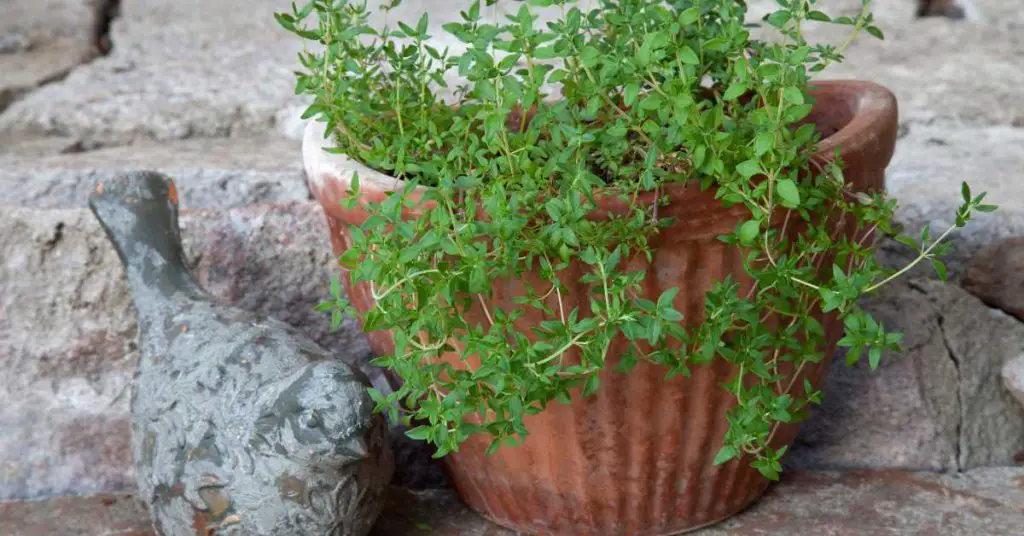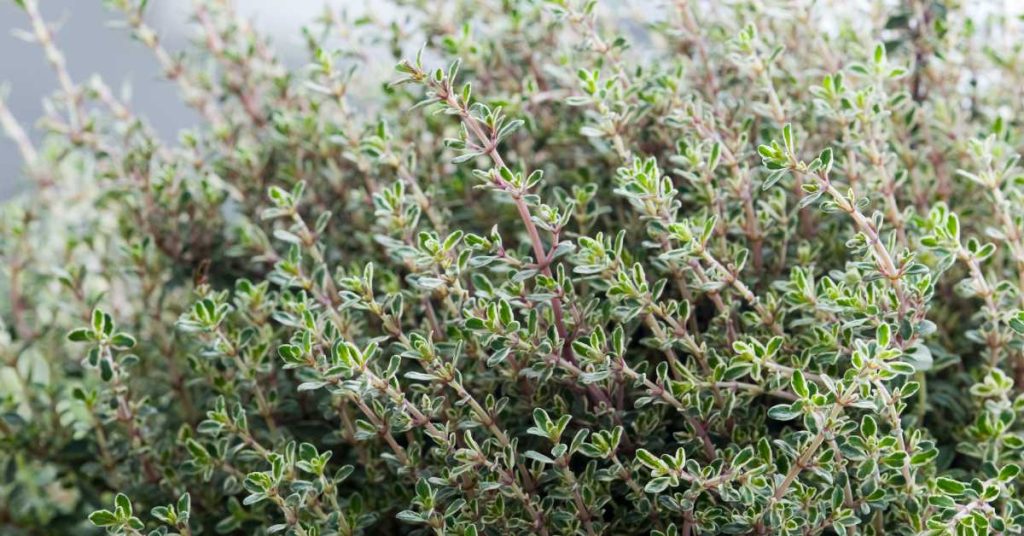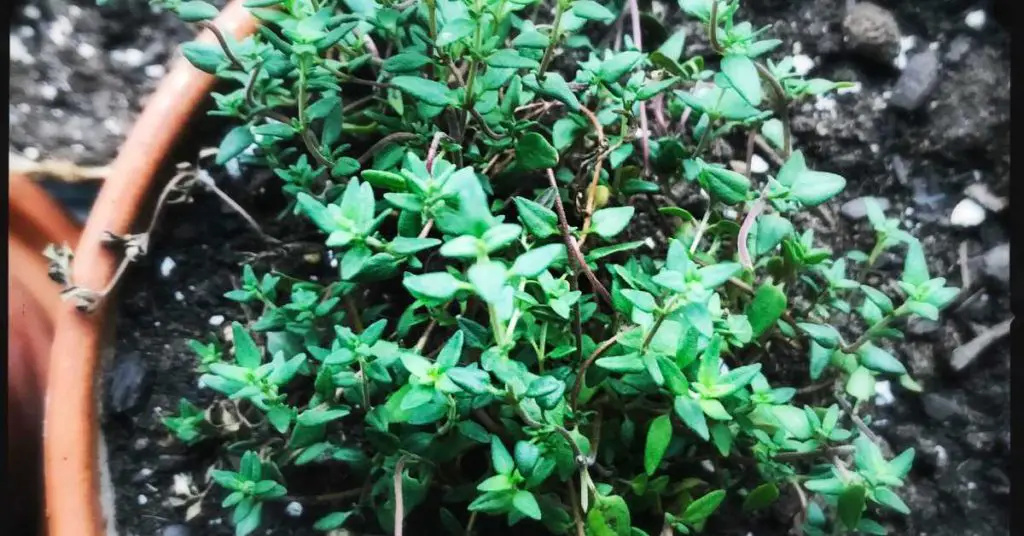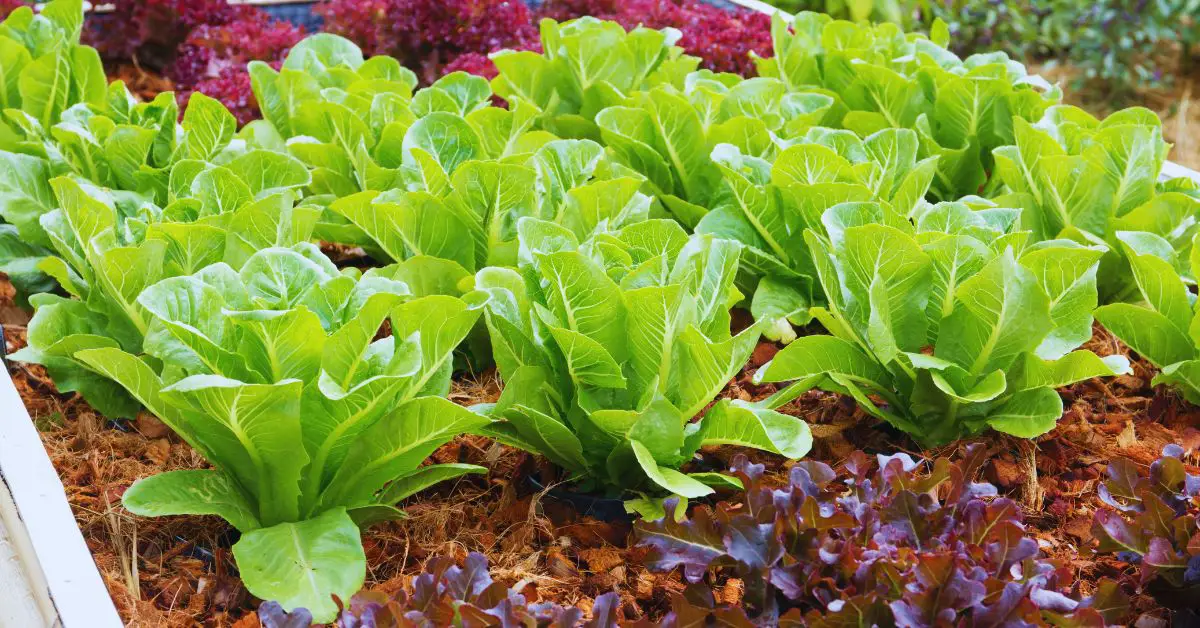Growing herbs in containers is a great way to add flavor and beauty to your home, and thyme is one of the easiest and most rewarding herbs to grow.
Whether you’re a novice or an experienced gardener, this complete guide will show you everything you need to know about growing thyme in pots.
Thyme is an incredibly versatile herb that can be used both fresh and dried in a variety of dishes.
It requires minimal effort to get started and with the right care and maintenance, it will reward you with delicious harvests all year round.
Read on for all the tips, tricks, and advice you need to grow your own thriving thyme in a pot.
Growing Thyme In Pots: What Are The Benefits?
Growing thyme in pots is a great way to add flavor to your cooking while having fun with gardening. Not only are there many benefits of growing thyme, but there are also some important steps to take in order to get the best results.
When it comes to harvesting techniques, you can either pick off individual leaves or snip larger bunches as needed. To keep your soil healthy and maximize growth, make sure to maintain adequate drainage and water levels.
When it comes to pest control, it’s important to deter pests before they become a problem by regularly checking for signs of infestation and taking immediate action if necessary. In terms of pot size selection, bigger isn’t necessarily better — you want a pot that is big enough for your plant’s root system without being so large that it retains too much moisture.
Finally, when preparing for winter months, bring potted thyme indoors or cover them with mulch for protection from frost and wind. Taking these steps will ensure you have plenty of tasty herbs all year round!

What You Need To Grow Thyme In Pots
Growing thyme in pots is like taking a journey. It may seem intimidating at first, but with the right preparation and resources, you can make it to your destination – a thriving pot of thyme!
To get there, you’ll need to be aware of the specific nutrient requirements, soil types, water needs, harvesting techniques, and pest control methods that work best for this particular herb.
When it comes to choosing the right soil type for your thyme plant, look for something that drains well while still retaining some moisture.
When it comes to fertilizing and nourishing your plant, use an organic compost or fish emulsion every few weeks during the growing season.
Regular watering is important too; aim for about 1 inch per week.
As far as pests go, if you notice any issues such as yellowing leaves or mildew-like patches on your thyme plant’s leaves, you can use diluted neem oil or insecticidal soap to solve the problem.
Finally, when harvesting your thyme be sure to snip off stems just above a leaf node so that new branches will continue to grow.
With these tips in mind and a little patience and care on your part, you’ll soon have a delicious pot of homegrown thyme!
Varieties Of Thyme To Grow In Pots
Growing thyme in pots can be a rewarding experience, but there are a few things to consider before diving in.
After you’ve gathered the necessary supplies, it’s time to select the best variety of thyme for your environment. There are many varieties of thyme with different growing requirements and flavors that you can choose from.
The most important step when selecting the variety of thyme is determining the amount of space available for each plant and understanding the proper pruning techniques and fertilizers used for each type.
Additionally, companion planting can help you maximize your herb garden by creating a balanced ecosystem while also adding flavor combinations to your meals.
Finally, be sure to research how long it takes to harvest each variety as well as any disease prevention techniques you should use.

How To Grow Thyme In Pots
When it comes to growing thyme in pots, the right pot can make all the difference. Picture a carefully chosen terracotta pot with subtle curves, large enough to accommodate the spreading of thyme’s delicate leaves. The pot should be at least 8 inches deep – anything shallower will prevent your thyme from establishing healthy roots and reaching its full potential.
As for soil, look for something light and well-draining, such as a mix of compost, peat moss, sand and perlite.
Watering tips are especially important when it comes to growing thyme in pots – too much water can suffocate the plant’s roots and lead to rot. Make sure to water only when the top layer of soil is dry; this generally means every few days in hotter months but every week or two in cooler seasons.
Fertilizer use should also be kept minimal; just an occasional dose of organic compost or fish emulsion is usually more than enough. To further protect your plant, consider companion planting with other herbs that share similar needs; parsley and rosemary are great choices!
When harvesting your thyme, wait until it reaches 6 inches tall before snipping off only what you need; this will help ensure that your plant is able to keep producing fresh new growth over time.
With these tips in mind, you’ll be sure to have success growing thyme in pots!
How To Plant Thyme In Pots Or Containers
Planting thyme in pots or containers is a great way to get the herb garden of your dreams. To start, choose a pot that is at least six inches deep and has good drainage.
The type of soil you use can also make a difference; it should be light and well-draining with plenty of organic matter. As for watering needs, thyme likes moist soil but not wet, so water when the top inch or two becomes dry.
In terms of pest prevention, ensure you have screened off any bugs before planting and keep an eye on any potential problems. Additionally, it’s important to understand what kind of soil types are best for growing thyme; sandy soils are ideal for growth due to their excellent drainage properties.
Here’s a list of tips to help you get started:
- Water when the top inch or two become dry
- Keep an eye out for pests
- Use sandy soils with excellent drainage properties
- Choose a container that is at least 6 inches deep
Finally, remember to harvest regularly as this will encourage further growth and allow you to enjoy your thyme all season long!
Should I Start Thyme From Seeds Or Buy Seedlings?
Starting thyme from seed or buying seedlings is a personal preference. For those looking to start growing thyme, the decision largely depends on the amount of time you have available and the energy you want to invest in the process.
When sowing thyme seeds, timing is key as it is a plant that does best in cool temperatures. It’s also important to choose the right size container for your indoor potting needs—a six-inch pot should be enough for one or two plants.
Sunlight requirements are also essential; thyme enjoys full sun, so make sure your pot is placed in an area where it will get at least four hours of direct sunlight per day. Soil preparation should include adding organic matter and ensuring good drainage—this can easily be achieved by mixing sand with soil before planting.
Finally, keep an eye out for pests and use organic products such as neem oil if needed to control them. Overall, starting thyme from seed or purchasing seedlings can be rewarding experiences if done correctly. It’s important to remember that this delicate herb requires specific conditions to thrive; paying attention to detail and creating a healthy environment will ensure success in growing this delicious herb!
How To Grow Thyme From Seed
Growing thyme from seed is relatively easy and requires minimal effort. Start by obtaining a quality, organic seeds from a reputable seller.
Once you have the seeds, spread them over a potting mix that is well-drained. Make sure to keep the soil moist but not overly wet for optimal germination rate. Additionally, be sure to maintain the temperature at around 70 degrees Fahrenheit for best results.
Once the thyme seedlings are established, prune them regularly to encourage healthy growth and prevent legginess due to too much light exposure. This will also help create bushier plants that produce more flavorful leaves when harvested and used in cooking.
When harvesting thyme leaves, cut off only what you need because they dry quickly after being cut off the stem. If you want to store your thyme for future use, it’s best to store it in an airtight container after drying it first in a cool, dark place.
How To Plant Thyme Seedlings
Now that you have a better understanding of how to grow thyme from seed, it’s time to talk about planting the seedlings.
Planting thyme seedlings is a relatively easy process, but there are a few tips and tricks that may make the process even simpler.
Like with any other plant, you must consider the feeding requirements, proper drainage, harvesting techniques, common pests, and container size when planting thyme seedlings.
To begin, it’s important to choose a pot with ample drainage holes and one that is not too large for the plant – if the pot is too big for the root system of your thyme plant, then it won’t be able to take up enough water or nutrients which can lead to root rot.
Providing adequate moisture is also essential for healthy growth; water in moderation but always make sure the soil doesn’t dry out completely. Additionally, fertilizing every few weeks can help promote foliage growth and ensure your thyme has all of the necessary resources for optimum health.
Harvesting is an easy process – simply snip off individual sprigs as needed while leaving enough foliage behind so that the plant continues to grow.
Finally, be mindful of common pests such as spider mites or aphids as they can cause significant damage if left untreated.
With these few simple steps in mind, you’ll be well on your way toward successfully growing thyme in pots!
How Do You Care For Potted Thyme
Thyme in pots requires regular watering, and the amount of water needed will vary depending on the size of the plant and the temperature. When watering thyme plants in pots, make sure to allow the soil to dry out between waterings.
It is also important to fertilize thyme plants in pots occasionally; a balanced, slow-release fertilizer can be used every four to six weeks.
Harvesting tips for thyme plants in pots include removing flowers as soon as they appear and pruning back the plant before it blooms.
Keep an eye out for pests such as aphids or whiteflies, and use methods such as insecticidal soaps or neem oil to prevent any damage from occurring.
When potting thyme, it is best to choose a good quality potting soil that drains quickly and allows for adequate air circulation around the root system.
These steps should help ensure that your potted thyme stays healthy and happy!
Does Thyme Grow Well In Pots?
Caring for potted thyme is both rewarding and challenging. Not only does it require special attention to keep it healthy, but also an understanding of its preferences and needs.
So, does thyme grow well in pots? Absolutely! With the right conditions and care, you can successfully cultivate thyme in a container.
Harvesting thyme regularly will help keep your plant bushy and productive while fertilizing it with a balanced fertilizer once every two weeks during the growing season will provide essential nutrients. Additionally, pruning thyme helps promote healthy growth by removing any dead or damaged foliage as well as unproductive stems.
To prepare for winter, consider moving your pot indoors or providing extra insulation such as adding mulch or straw around the base of the plant. For best results incorporate companion planting with other herbs such as oregano and rosemary for better flavor and improved productivity.
When caring for potted thyme, remember that consistency is key. Ensure that your plant receives enough sunlight, water, and fertilizer to help it thrive throughout all seasons. With proper care and attention, you can enjoy fresh harvests of fragrant thyme year-round!
Is It Easy To Propagate Thyme?
Propagating thyme is relatively simple and straightforward.
To get started, it is important to first understand the basic requirements of growing thyme in pots. This includes understanding the necessary soil requirements such as pH levels, drainage needs, and essential nutrients.
It is also important to be aware of the container size that you should use when growing thyme in pots as this will play a major role in how successful your propagation efforts are.
In addition to the soil and container size requirements, it is also important to pay attention to watering needs for your thyme plants. Be sure not to overwater them as this can lead to root rot or other issues with your plants.
Additionally, pest control should be considered when propagating thyme as there are many pests that can cause damage to these plants if not taken care of properly.
Lastly, when harvesting tips from your thyme plant make sure you do so in a way that does not harm the plant itself.
Once all of these requirements are met, then propagating thyme can be relatively easy and rewarding! With patience and proper care, you can have a thriving crop of thyme in no time.
Does Thyme Come Back Every Year?
Yes, thyme is perennial in most warmer climates and will come back year after year if you take good care of the plants.

Frequently Asked Questions
What Is The Best Time Of Year To Plant Thyme In Pots?
Planting thyme in pots is best done during the spring season when the weather begins to warm and the days are becoming longer.
It is important to consider several factors when planting thyme in pots, such as pruning techniques, fertilizing methods, container selection, light exposure, and soil type.
When selecting a pot for growing thyme, be sure to select one with plenty of drainage holes.
Also, ensure that thyme is planted in an area that receives ample sunlight throughout the day.
Additionally, use soil that is well-draining and rich in nutrients.
Finally, make sure to provide regular pruning and fertilization so that your thyme plant grows healthy and strong!
How Often Should I Water Potted Thyme?
Watering your potted thyme regularly is key to keeping it healthy. The frequency of watering will depend on the size of the pot, soil drainage, and weather conditions. Generally speaking, you should water when the soil is dry to a depth of 1 inch.
Fertilizing requirements are minimal; a balanced fertilizer can be applied every two weeks during the growing season.
When harvesting tips, simply snip off sprigs as needed from the outside of the plant.
Is There A Specific Soil Ph Requirement For Growing Thyme In Pots?
Cultivating thyme in containers can be a rewarding experience, but you need to make sure that the soil pH is just right.
Fertilizing requirements, container size, harvesting techniques, and pest management are all important elements of this task, as well as ensuring adequate soil aeration.
Too high or too low pH levels will have a negative effect on your thyme’s growth, so it’s essential to get it right!
How Much Sunlight Does Potted Thyme Need?
Potted thyme needs plenty of sunlight to thrive, so it should be placed in a location that receives at least six hours of direct sun per day.
If overwintering potted thyme, you’ll want to choose a container that’s large enough for the plant and has adequate drainage.
Before transplanting, check the pH of your soil and consider any drainage considerations you may have.
This will ensure your plant is getting the optimal environment for growth.
How Long Does It Take For Thyme To Mature In A Pot?
Thyme is a hardy and versatile herb that can be grown in pots, but it does take some patience for the plant to mature.
It usually takes between four to six months for thyme to reach its full growth potential in a pot, depending on your pruning methods and how well you can control the temperature, fertilizer types, companion planting, and pest prevention.
All of these factors play an important role in ensuring that your thyme will reach its maximum growth potential in the shortest amount of time.
Conclusion
The beauty of growing thyme in a pot is that you can enjoy its flavor and fragrance year-round. With proper care, this fragrant herb can bring a delightful scent to your garden or patio. So don’t be afraid to give it a try – you won’t regret it!
Thyme is an easy herb to grow in pots and requires minimal effort, making it ideal for beginner gardeners. It’s like having a little slice of nature right at your fingertips – a vibrant reminder of the beauty of the outdoors that’ll bring joy to your life.
As they say, ‘A sprig of thyme is worth two in the bush!’





